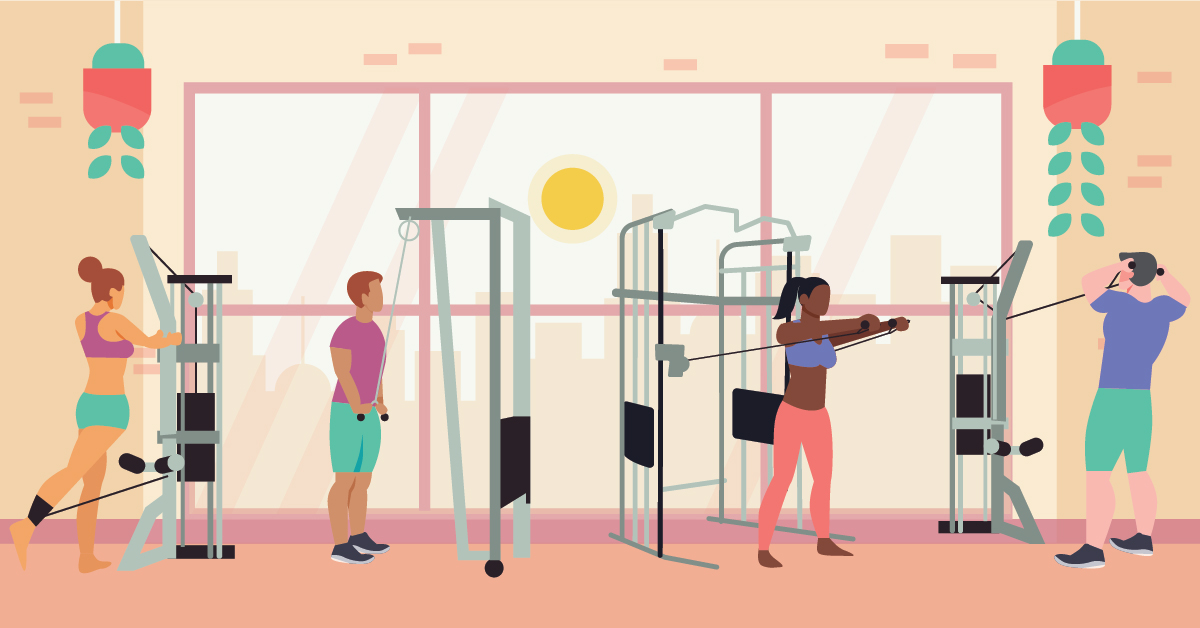As free weights gain in popularity, you may be missing out on the benefits of a cable machine. This functional exercise equipment takes up a decent amount of real estate on the gym floor —and for a good reason. Though many gym-goers limit themselves to a few arm exercises at the cable machine, this versatile tool allows you to pull, press, twist, and hinge your way to a stronger, more powerful body without feeling locked into a single motion.
You may notice a handful of attachments lying around the cable machine, each of which has its own unique method of use. We’ll break down exactly when and how to use those attachments, then illustrate our 21 top cable exercises to add to your routine. Before we dig into it, let’s discuss why you should consider the cable machine in the first place.
What Is a Cable Machine and Why Should You Use One?
The cable machine is a multifaceted pulley system used for both functional and strength training. It’s comprised of a steel frame and has weighted stacks attached to cable pulleys on all sides.
Typically, the two outer sides feature a single adjustable pulley that can move from below the ankles to over your head. You may have various sections on each side of the machine explicitly used for back, chest, and shoulder training. Some cable machines also include a two-sided pulley system in the middle.
The weighted stacks vary from machine to machine, but typically run from 10 pounds up to 225 pounds or more. Depending on the machine, the weights tier up by 10 to 25 pounds. Some machines have five-pound weights that raise and lower onto the stacks so you can increase your weight more gradually.
Cable exercises mix well with various weighted and bodyweight exercises. You can also create an entire workout routine using only the cable machine. With cables, you can practice specific movement patterns without loading the spine and safely learn resistance training without the fear of dropping weights or missing a lift.
How to Use a Cable Machine
The first rule of cable exercises: don’t put your fingers between the weight stacks at any time. Now that we cleared that up, time to set the stage for your first cable workout.
Choose your attachment
Cables have various attachments that allow you to perform different exercises. There’s no set rule of pairing attachments to specific exercises, which makes cables a lot of fun and creative.
Once you learn how to use cables, you can play around with different attachments. For now, we’ll stick to the gold standards.
Single stirrup handles
Single handles work best for upper body exercises that use one hand to grip the attachment. These handles are primarily used for single-arm exercises like bicep curls and tricep kickbacks. You can also use them for chest presses and flys, shoulder presses, lateral raises, standing rows, and woodchoppers.
Rope
The rope is a crowd favorite for tricep press downs. You can also use them for double-arm biceps curls, face pulls, straight-arm pulldowns, cable pull-throughs, and hip rotations.
Seated row handle
You’ll usually find the D-handle attached to the seated row section of the cable pulley. You can also use this attachment for close-grip lat pulldowns and bicep curls.
Revolving straight or curl bar
This bar rotates as you move, so you get a full range of motion. It’s great for any exercise that requires a bar. This can include bicep curls, tricep press downs, French presses, upright rows, and pullovers.
Revolving lat bar
You probably guessed this is the bar used for lat pulldowns. It has a wider angle and is typically covered with gripping material. You can also use this bar for rows and other upper body exercises.
Triceps handle
This V-shaped handle is another great tool to build triceps strength. You can use it for press downs, French presses, and several other arm exercises.
Ankle straps
These are great for training your lower body. Some exercise options include glute kickbacks, standing hip abduction and adduction, and standing knee lifts.
Set up the machine for optimum performance
Before you begin exercising, you’ll need to adjust the cable height, bench padding, or knee padding depending on the section of the cable machine you use. When in doubt, you can refer to the instructions on the machine or ask a trainer.
Choose the right weight
If you’re new to cable training, start at a lighter setting. You can adjust the weight up or down by pulling out the pin and re-inserting it into the stack. Use a weight that allows you to perform your given amount of reps with good form at the full range of motion.

Putting it All Together
Now that you have a solid understanding of the cable machine in your gym, it’s time to get to work. You can add any of the above exercises to your regular workout routine — or you can create a total-body cable-only workout. Use two to three sets with a rep range of eight to 12 for each exercise. Once you warm up to the cable machine, you’ll see how cables add variety to your workouts and help you feel more comfortable using specific muscle groups under tension.
